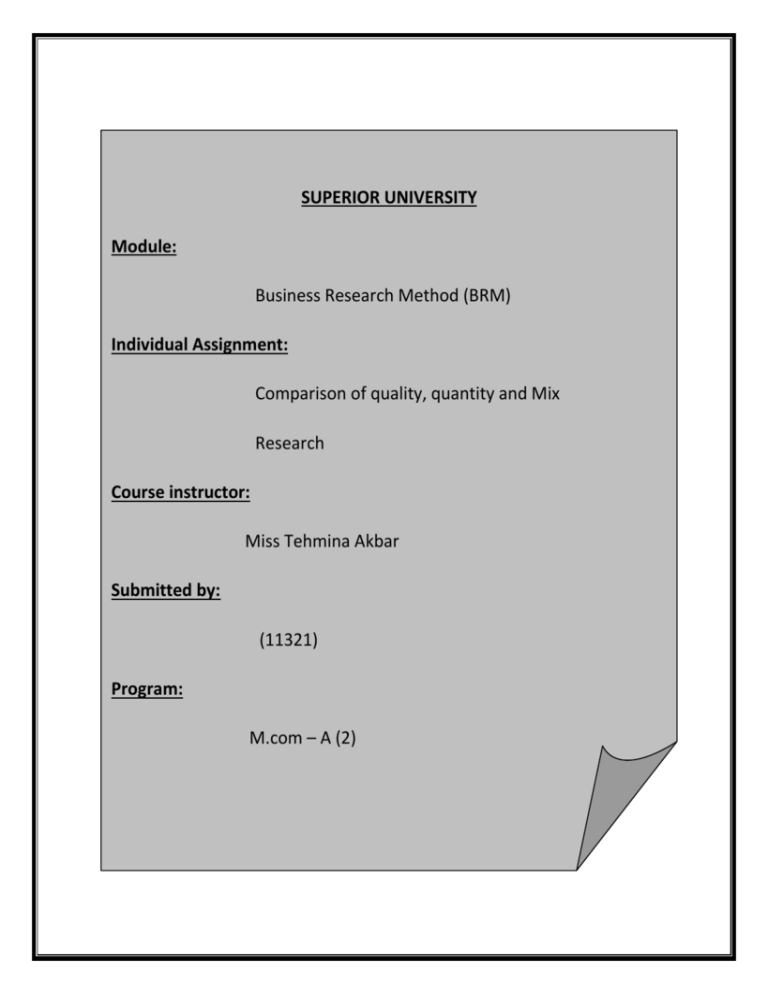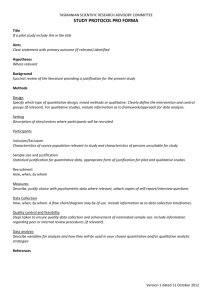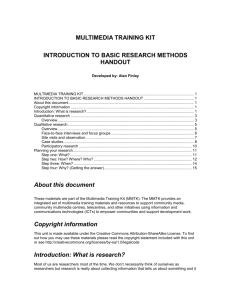comparison of quality, quantity and mix research
advertisement

SUPERIOR UNIVERSITY Module: Business Research Method (BRM) Individual Assignment: Comparison of quality, quantity and Mix Research Course instructor: Miss Tehmina Akbar Submitted by: (11321) Program: M.com – A (2) INTRODUCTION TO RESEARCH: Good research reflects a sincere desire to determine what is overall true, based on available information; Good research requires judgment (or discernment) and honesty. Where as bad research that starts with a conclusion and only presents supporting factoids (individual facts taken out of context). Bad research often contains jumps in logic, false arguments, and nonsequiturs (“it does not follow”). Bad research often uses accurate data, but manipulates and misrepresents the information to support a particular conclusion. TYPES OF RESEARCH QUALITATIVE RESEARCH: Qualitative research is used to gain insight into people's attitudes, behaviors’, value systems, concerns, motivations, aspirations, culture or lifestyles. It’s used to inform business decisions, policy formation, communication and research. Focus groups, in-depth interviews, content analysis.1 QUANTITATIVE RESEARCH: By DJS Research Ltd Quantitative research is used to measure how many people feel, think or act in a particular way. These surveys tend to include large samples - anything from 50 to any number of interviews. Structured questionnaires are usually used incorporating mainly closed questions - questions with set responses. There are various vehicles used for collecting quantitative information but the most common are on-street or telephone interviews.2 MIX RESEARCH: Mixed research (also commonly called mixed methods research) is research in which the researcher uses a combination of quantitative and qualitative approaches in a single research study. Recent meta-analyses about mixed method studies (cf. BRYMAN 2005) have shown that qualitative and quantitative methods are often combined in ways which lead to unrelated research results. Although it has often been emphasised that qualitative and quantitative methods should be combined to use their „complementary strengths and non-overlapping weaknesses.3 1 http://www.qsrinternational.com/what-is-qualitative-research.aspx http://www.marketresearchworld.net/index.php?option=com_content&task=view&id=11&Itemid=64 3 http://www.google.com/search?hl=en&biw=963&bih=544&q=mixed+qualitative+and+quantitative+rese arch&aq=9c&aqi=g-c10&aql=&oq=MIXresearch 2 COMPARISON OF QAULITY, QUANTITY AND MIX RESEARCH S. no CRITERIA QUALITY RESEARCH PURPOSE To understand & interpret social interactions. To understand & interpret social interactions. To test hypotheses, look at cause & effect, & make predictions. Explanatory Descriptive or causal Hybrids which have elements of both research traditions Usually a small number of non-representative cases. Respondents selected to fulfil a given quota. Usually a large number of cases representing the population of interest. Randomly selected respondents. Quantitative pilot studies can help to guide the selection of cases in qualitative (smallN) studies, Structured techniques such as online questionnaires, onstreet or telephone interviews Use different methods of data collection and analysis within a single research paradigm4. Ethnographies5 may help to understand previously incomprehensible 1 2 TYPE OF RESEARCH 3 SAMPLE QUANTITY RESEARCH . 4 DATA COLLECTION 5 DATA ANALYSIS Unstructured or semistructured techniques e.g. individual depth interviews or group discussions. Non-statistical 4 Statistical data is usually in the form of tabulations (tabs). Findings are conclusive and usually descriptive MIX RESEARCH To increase the quality of final results and to provide a more comprehensive understanding of analyzed phenomena. A term used to refer to a set or cluster of commonly-held beliefs or values within the research or scientific community about a field of study. 5 Ethnography: a form of qualitative research focused on describing the culture of a group of people. 6 ADMINISTRATION 7 HARDWARE 8 TRAINING OF THE RESEARCHERS 9 OUTCOMES 6 7 in nature. statistical correlations. Requires interviewer with special skills Fewer special skills required Tape recorders, projection devices, videos, pictures, discussion guides Questionnaires, computers, printouts Psychology, sociology, social psychology, consumer behavior, marketing, marketing research Statistics, decision models, decision support systems, Computer programming, marketing, marketing research Requires variety of skills Philosophically, mixed research takes an eclectic, pragmatic6, and commonsense approach Researcher should mix methods or procedures in a way that the resulting mixture or combination has complementary strengths and non overlapping weaknesses. Results from qualitative interviews can help to identify unobserved heterogeneity7 in quantitative data as well previously unknown explaining variables and misspecified models. Exploratory and/or investigative. Findings are not conclusive and cannot be used to make generalizations about the Used to recommend a final course of action. Dealing or concerned with facts or actual occurrences; practical. Fundamental characteristic of services which results in variation from one service to another, or variation in the same service from day-to-day or from customer-to-customer. Heterogeneity makes it hard for a firm to standardize the quality of its services. Opposite of homogeneity. FINAL REPORT 10 Narrative report with contextual description & direct quotations from research participants. Statistical report with correlations, comparisons of means, & statistical significance of findings. 8 8 http://www.snapsurveys.com/techadvqualquant.shtml Mixed research uses both deductive and inductive methods, obtains both quantitative and qualitative data, attempts to corroborate and complement findings, and takes a balanced approach to research.








